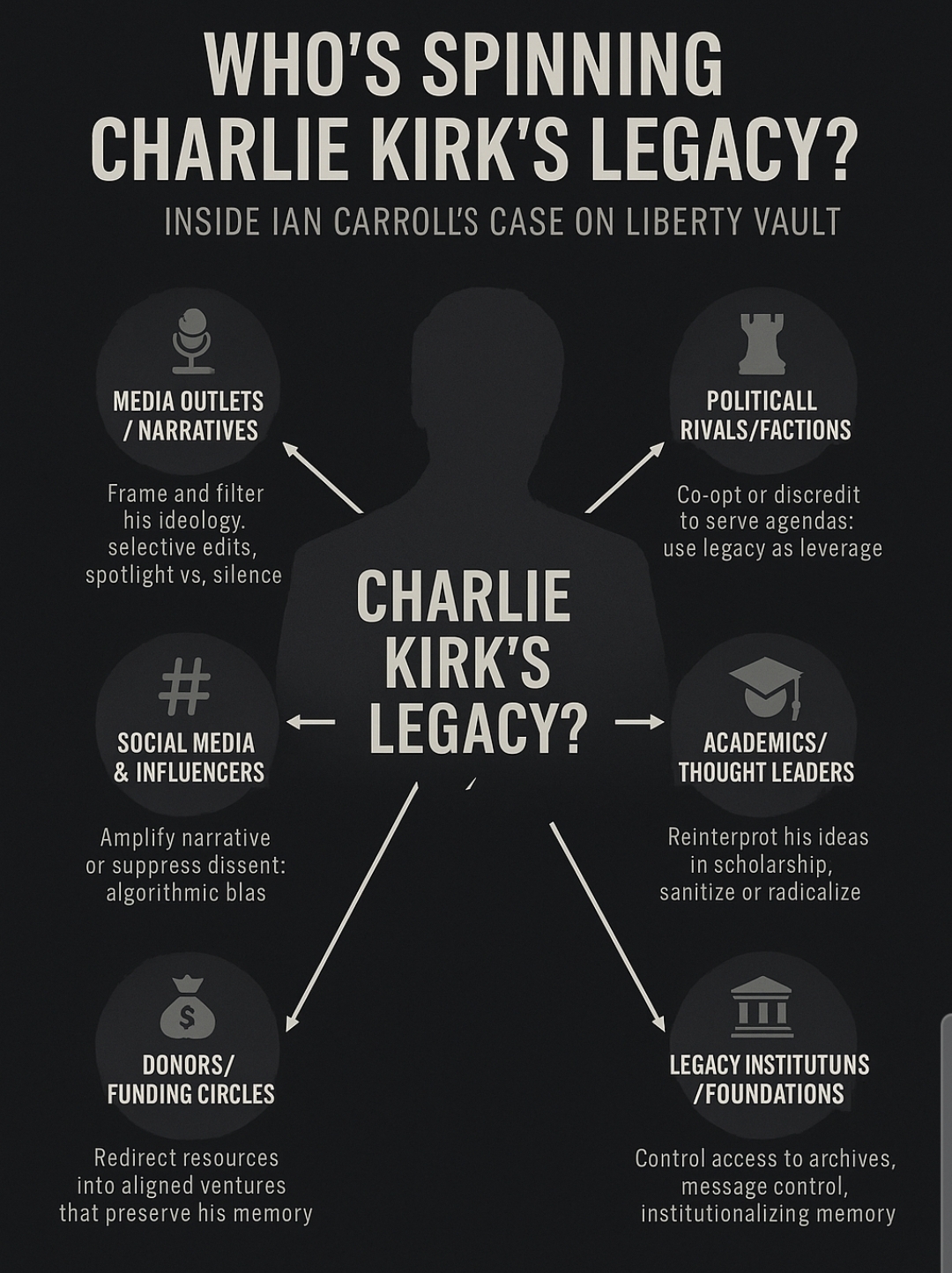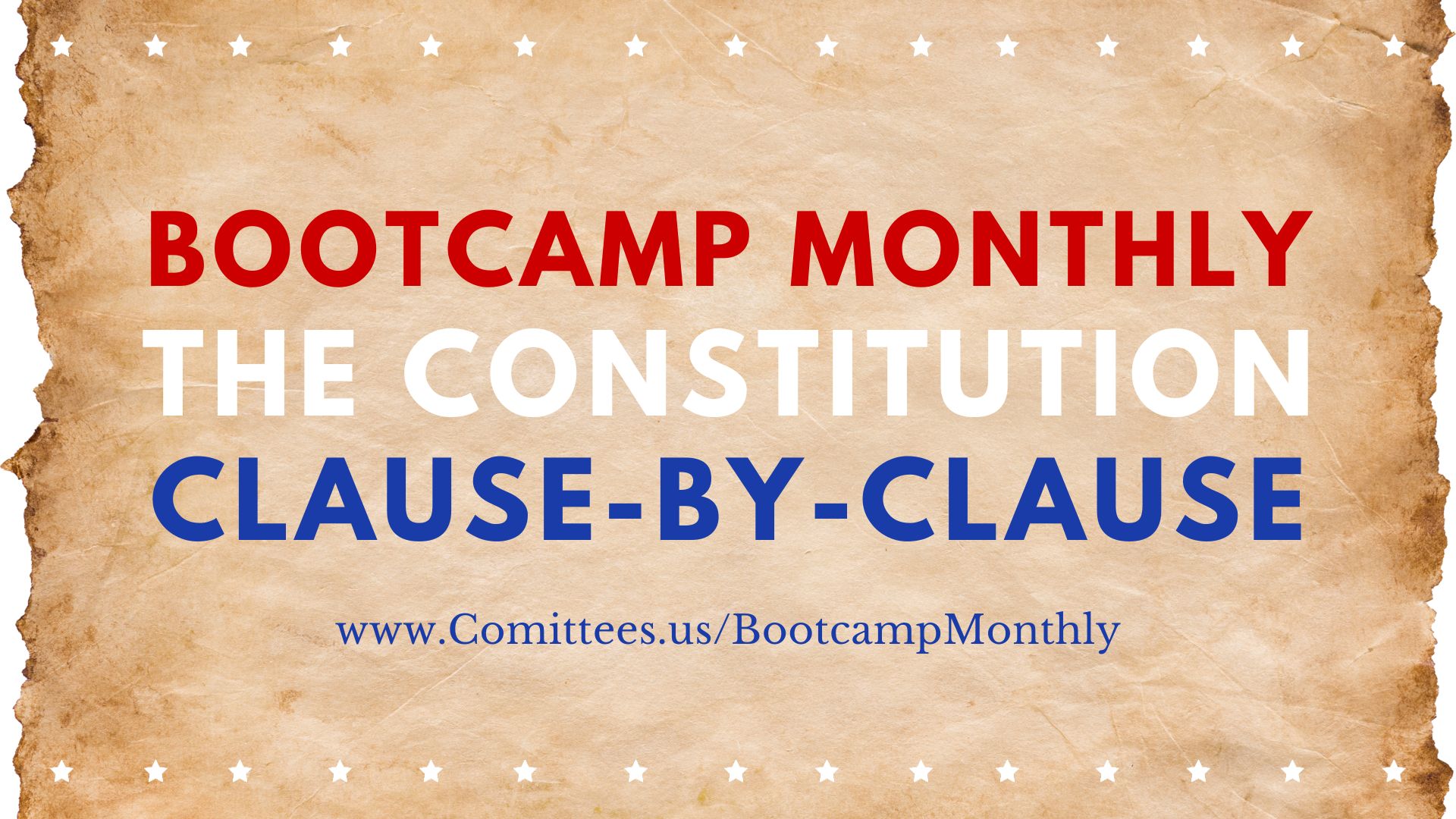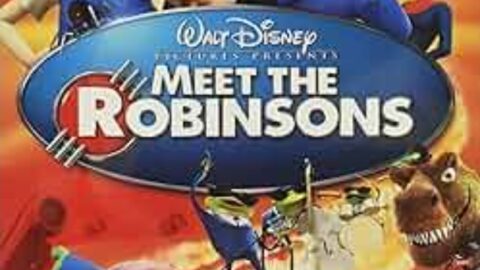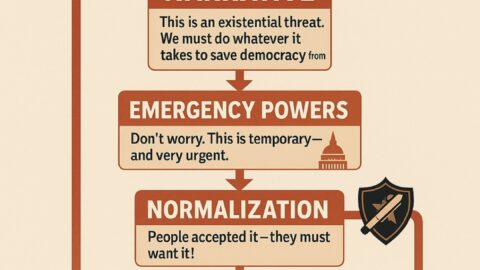In a charged Liberty Vault episode, the host dissects one of Ian Carroll’s episodes, which includes his guest map on the competing over Charlie Kirk’s final months—his Israel stance, donor pressure, and the battle to define what he stood for. Here’s the argument, cleaned up and laid out, drawn solely from the video presentation.
There were three overlapping battles: over Kirk’s views on Israel, the influence of major donors, and the larger fight over free speech. Here’s how the arguments unfold.
The three overlapping battles
1) What were Charlie Kirk’s views on Israel?
- Not “Ben-Shapiro Zionism,” but still pro-Israel. The host says Carroll’s clip chooses moments where Kirk defends Israel as an ally and rejects Jew-hate, yet pushes back on the reflex of labeling dissent “antisemitic.” A July town-hall exchange is used to show Kirk agreeing with Gen-Z critics that the term “antisemitism” is being overused to shut debate, even as he affirms positive experiences in Israel and calls it a country he supports.
- Coalition management. Kirk is portrayed as juggling two constituencies inside Turning Point USA: (a) big donors who want harder pro-Israel messaging, and (b) a younger base more skeptical of endless funding and hawkish policy. The host argues this tension explains why he sometimes sounded scripted and other times more open to criticism of the Netanyahu government.
- “Freedom to criticize.” The episode features remarks attributed to Kirk’s producer, Andrew Kolvet, summarizing Kirk’s position as: “I like Israel more than Hamas, but I wish I were free to criticize a foreign government without being called antisemitic.” The loss of some donors after a Tucker Carlson appearance is cited as evidence of real costs when he allowed dissenting voices.
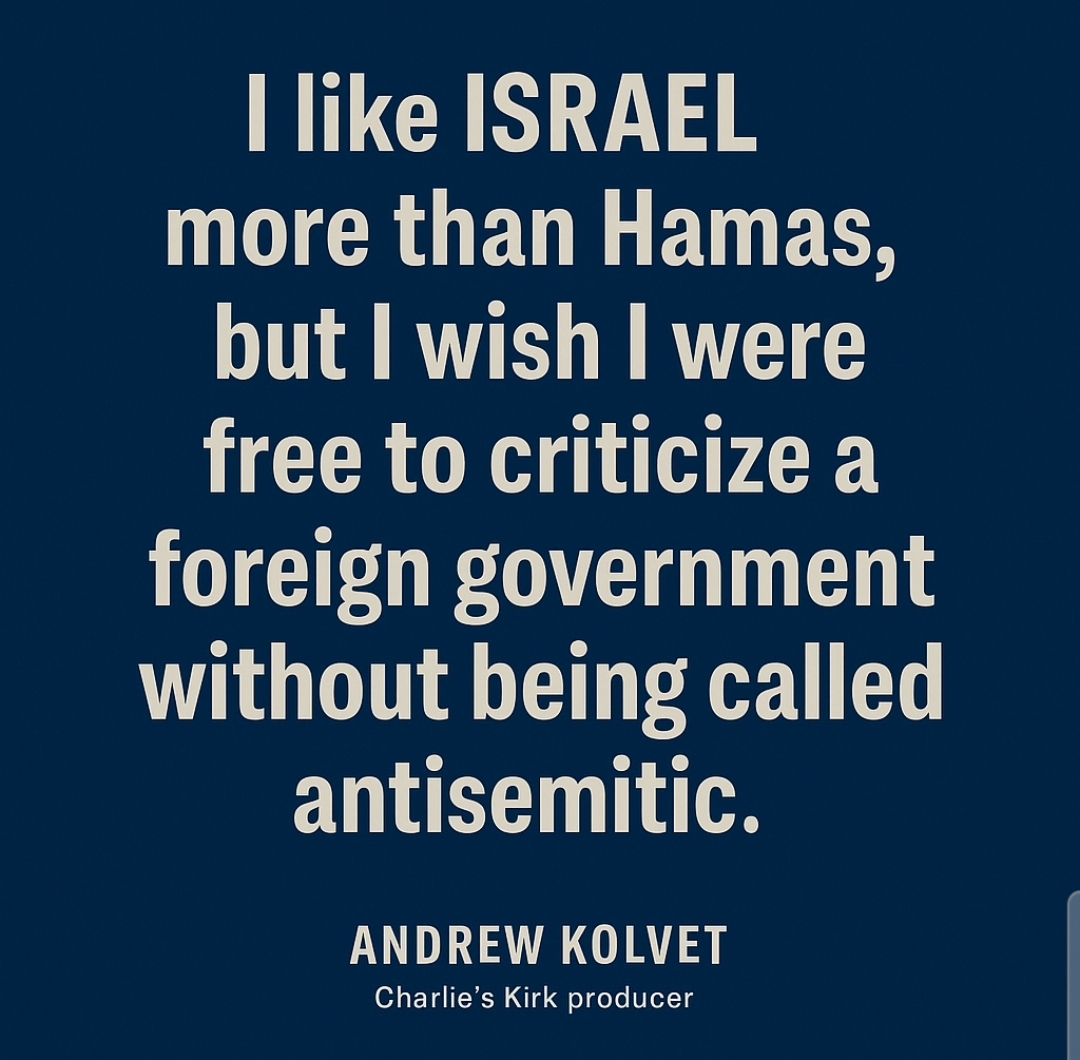
Why this matters in the video’s logic
- Carroll’s cut—and Liberty Vault’s read of it—presents Kirk as trying to carve out space between supporting Israel’s existence and refusing speech codes that equate policy critique with bigotry.
2) Did donor pressure shape what he could say?
- The “leaked texts.” A critic of Owens posts messages purporting to show a Kirk confidant insisting “Candace must say X and Y” about Israel to make the controversy stop, with Kirk replying “This is right, I’m really trying to help her.”
- Owens’ rebuttal (in the video): She says the messages were from 2023, stripped of dates to fabricate a “falling-out” narrative, and actually prove the pressure script, not a rift.
- Funding threat claims. The host references reporting (as a claim) that a prominent Zionist donor pulled support from TPUSA as Kirk platformed more critical voices. In the episode’s telling, this illustrates how money polices the boundary of acceptable speech.
- Producer’s confirmation of costs. Kolvet is quoted saying donor blowback did occur, and that not all pushback came from Jewish donors—evangelical Zionists mattered too.
Why this matters in the video’s logic
- The donor fight is the mechanism that turns an abstract “speech climate” into real consequences—bookings, budgets, guest lists, and who gets a mic.
3) The broader fight over free speech and labels
- “Antisemitism” as a speech veto. Carroll’s episode, as summarized by the host, argues that the term is sometimes deployed like “racism” was in other debates—as a conversation stopper rather than a precise description of hatred. This, they say, alienates younger audiences and backfires.
- Platforming under pressure. The host points to pressure campaigns—demands to apologize for the line “genocide is always wrong,” guest slots tied to messaging litmus tests, and post-appearance pile-ons—as evidence that speech is being policed by donors, PR shops, and allied media.
- A media flashpoint. As a cautionary tale about climate, the episode nods to a separate TV dust-up (a host walking off mid-show during a segment critical of Israel). The point is not to settle that dispute but to show how touchy and combustible the topic had become across outlets.
Why this matters in the video’s logic
- The “who decides what can be said” question is the meta-fight that shapes both the Israel discourse and the donor theater. The episode frames Kirk as a case study in navigating (and straining against) those limits.
The guest-map: who is claiming what
- Candace Owens: Says there was no falling-out with Kirk; contends Zionist donors and operatives tried to script what she must say; refuses to apologize for “genocide is always wrong.” Uses dated events (tours, conference appearances) to support her timeline.
- Andrew Kolvet (Kirk’s producer): Portrayed as clarifying that Kirk stayed pro-Israel but resented being branded antisemitic for criticism; acknowledges donor losses after hosting Tucker; stresses not all pushback came from Jewish donors.
- Critics (e.g., “leak” promoters, TV pundits): Use text snippets and on-air assertions to claim Kirk distanced from Owens and maintained unwavering pro-Israel lines; the Liberty Vault host says these are contested by dates/context.
- Reporters/commentators (e.g., Max Blumenthal in the episode’s telling): Allegations of named donors exerting pressure or cutting funds are cited as claims that fit the donor-influence pattern Carroll highlights.
- Political figures (Netanyahu media hits): The episode criticizes immediate spin after the assassination as opportunistic—folding the tragedy into a broader “terror” frame—which the host says Kirk himself was increasingly wary of endorsing without caveat.
Where the episode says these threads converge
- Israel stance: Kirk tried to hold a nuanced line—support Israel, reject Jew-hate, but keep space for policy critique.
- Donor influence: That nuance cost money, bookings, and goodwill with some funders.
- Free speech: The policing of language and labels turned policy debate into a loyalty test, which the host argues Kirk increasingly resisted.
Open questions the video leaves the viewer with
- How much did Kirk’s views shift, and when? Selective clips can’t settle trajectory.
- What, exactly, did donors demand or withdraw? Assertions exist; hard documentation is uneven or private.
- Where is the line between combating bigotry and chilling debate? The episode argues the line is currently blurred.
The Liberty Vault host’s bottom line
- Legacy fight: After a public figure’s death, narratives compete—friends, critics, donors, and media each claim the “real” him.
- Carroll’s frame: By foregrounding donor scripts, “anti-Semitism” label fights, and messaging discipline, Carroll urges viewers to see Kirk as pushing against a narrowing Overton window rather than abandoning allies.
- Caveat to the audience: Treat all of this as claims from a charged video—useful for mapping the debate, not for closing it. Verify timelines, seek primary sources, and distinguish critique of a government from judgments about a people.
Reader guardrails
- Attribute precisely (“the video claims,” “the host argues”).
- Don’t collectivize blame.
- Separate policies and institutions from peoples and faiths.
- Prefer dated documents, full transcripts, and named sources over screenshots and vibes.
Bottom line: The episode argues that the real story of Kirk’s final months sits at the intersection of stance, sponsors, and speech—and that understanding any one of those without the other two guarantees a distorted picture.
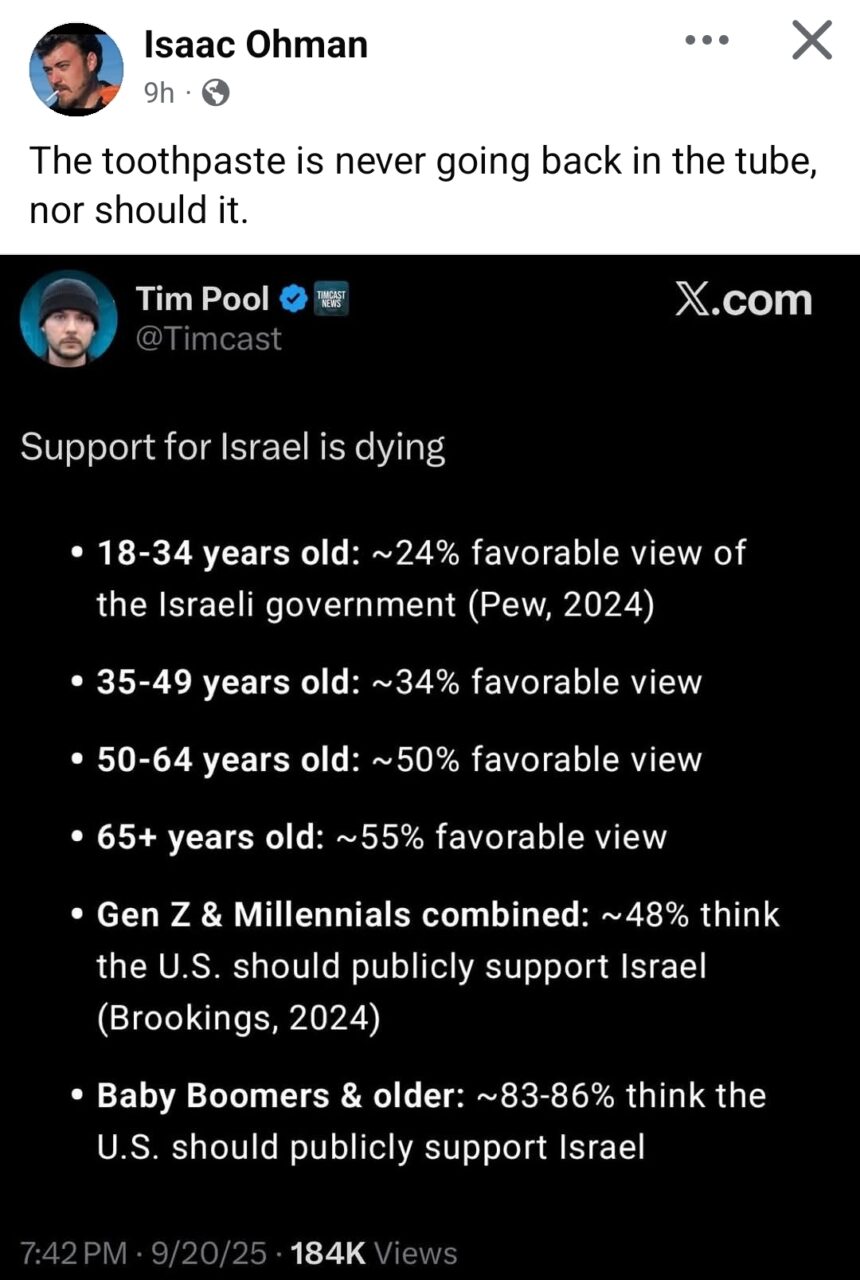
3. The Free Speech Flashpoint
- Pam Bondi’s comments: The Attorney General’s suggestion that “there’s free speech and then there’s hate speech” set off alarm bells. Carroll frames it as the ultimate betrayal of Kirk’s core principle—free expression.
- Why it matters: For Carroll and his guest, attempts to legislate “hate speech” laws don’t just dishonor Kirk—they weaponize his death to push censorship. They argue this must be a red line for civil disobedience.
4) Candace Owens as Catalyst
Carroll’s framing: Candace Owens is the spark that blows the lid off the “don’t-touch-it” zone around Charlie Kirk’s Israel stance. By putting pointed questions and timelines in front of a massive audience, she turns a private power struggle (donors, bookings, message discipline) into a public argument. Carroll credits her with “breaking the internet” on this topic and creating oxygen for follow-on reporting.
What he says she actually did:
- Focused the lens on one line. Owens’s “genocide is always wrong” tweet—followed by her refusal to apologize—becomes, in Carroll’s cut, the litmus case that exposes how speech about Israel is policed. The collision that follows (pushes to retract, loyalty tests, guest-booking pressure) is presented as evidence of a broader enforcement apparatus.
- Brought receipts, not rumors. Carroll highlights that she counters claims of a “falling out” with Charlie by pointing to dated, checkable facts: touring with him in early 2024, sharing the stage at TPUSA later that year, and aligning her timeline with texts he argues were stripped of dates. The method he praises is precision questioning—“show me the timestamp, show me the doc”—rather than free-form theorizing.
- Named the pressure scripts. In the clips Carroll uses, Owens reads or paraphrases messages she says were pushed at her and at Kirk (e.g., what she “must say” to make the controversy stop). Carroll presents these as talking-point demands—not persuasion, but conditions—illustrating how donor and lobby pressure allegedly tries to narrow acceptable speech.
- Surfaced the donor dimension. By amplifying claims (and encouraging investigative pieces) about donors pulling support when Kirk platformed dissenting voices, Owens—again, in Carroll’s framing—helps move the story from vibes to follow-the-money questions.
- Kept the tone forensic. Carroll repeatedly notes her on-camera pattern: don’t speculate, ask questions, withhold judgment until there’s paper. The effect, he argues, is that she leaves viewers with a nagging “this doesn’t add up” unease rather than a closed narrative—thereby widening the audience willing to look at documents when they appear.
Examples the video leans on as “proof of catalytic impact”:
- Viral reach. Carroll points to multi-million-view segments in which Owens scrutinizes claims about Kirk’s texts, donor pressure, and rapid post-assassination spin. He treats that virality as the distribution vector that lets other journalists (he names Max Blumenthal) publish deeper dives to an already engaged public.
- On-air confrontations elsewhere. The episode references a TV host walking off set rather than entertain criticism of Israel during a segment; Carroll uses that moment to argue Owens is forcing outlets to show their hand on whose speech gets oxygen.
- Counter-campaigns targeting her. Carroll includes clips of critics tagging federal officials over her satirical “CIA” merch, public demands that she apologize or be de-platformed, and claims of behind-the-scenes attempts to block her from TPUSA stages. He frames these as examples of the backlash machine that kicks in when a high-profile figure won’t recite the preferred lines.
How Carroll interprets the fallout:
- Targets on backs. He argues that, by pairing platform reach with receipt-driven challenges, Owens (and, in his view, Tucker Carlson) have put “targets on their back” from the pro-Israel lobby and aligned donor networks. In the film’s rhetoric, that means expect smears, booking pressure, and funding threats rather than open debate.
- Overton window shift. Regardless of whether viewers agree with Owens on policy, Carroll claims the procedural victory is real: it is now safer for prominent figures to say, “I support Israel’s existence and oppose antisemitism, and I reserve the right to criticize a foreign government without being labeled a bigot.” He counts that as movement of the debate’s boundaries.
Why this matters to his larger pattern:
- Narrative control vs. document demand. Owens’s role, as Carroll tells it, is to flip the asymmetry: instead of accepting moral framing (“say these two sentences or you’re out”), she drags the fight onto the field of timelines, contracts, donor lists, and full transcripts. In his schema—crime, intel, blackmail, narrative—this is the point where narrative can be contested by paper.
- From personalities to structures. While much of the media noise is Owens-vs-X, Carroll insists the real story is the apparatus her questions expose: how money conditions speech, how labels are used as vetoes, and how quickly institutional actors close ranks when a popular figure resists the script.
The above reflects how the episode and Carroll’s narration present Owens’s role—crediting her with catalyzing scrutiny and absorbing retaliation. Specific allegations about donors, lobbies, and behind-the-scenes pressure are claims from the video; readers should seek dated documents, primary sources, and multiple viewpoints before drawing conclusions.
5) Who Owns the Narrative?
Carroll’s framing: The fight over Charlie Kirk’s legacy isn’t just memorial politics—it’s a power struggle over the American right’s foreign-policy compass. In Carroll’s cut, two storylines sprinted to the podium the moment Kirk died: an official script from Jerusalem and a rebel counter-script from conservative media figures who say they knew what Kirk was privately wrestling with.
Netanyahu’s move: Preempt, canonize, assign blame
- Timing as tactic. Carroll flags how quickly the Israeli Prime Minister moved—before most Americans even knew Kirk had been pronounced dead, he says—to present Kirk as a steadfast ally and to frame the killer’s motive in familiar terms (“Islamists,” “radical extremists”).
- Selective quotation. The video argues Netanyahu read carefully chosen lines from a Kirk letter to imply uncomplicated alignment, while ignoring moments that showed Kirk’s discomfort with donor pressure or his disagreements with Netanyahu’s government. Carroll calls this “narrative triage”—stitch together the agreeable parts, discard the rest.
- Enemy naming. By immediately attributing the violence to the usual suspects, Carroll says, the PM used a patterned frame that serves a broader geopolitical agenda. The effect: fold America’s grief into Israel’s threat story, and do it fast enough that it feels like the default.
Why Carroll says it matters: First framing anchors memory. If the first version sticks—“Kirk the unambiguous Israel champion, felled by Islamist hate”—it narrows what the right is allowed to say next about Gaza, aid, and alliances.
The counter-narrative: Texts, producers, and on-air dissent
- Tucker/Owens/Smith as narrators. Carroll highlights segments from Tucker Carlson, Candace Owens, and Dave Smith pushing back on the canonization. Their composite claim: Kirk supported Israel’s existence but was skeptical of Netanyahu, uneasy with loyalty litmus tests, and stung by donor blowback when he platformed dissent.
- Receipts over vibes. The episode leans on messages attributed to Kirk and statements from Kirk’s producer, Andrew Kolvet—e.g., that Kirk “liked Israel more than Hamas” but wanted the freedom to criticize a foreign government without being labeled antisemitic, and that donor losses followed moves like hosting Tucker. (Carroll notes Kolvet added that some of the pushback came from non-Jewish donors, complicating a simplistic read.)
- Timeline rebuttals. Owens is shown producing dates and appearances to dispute talk of a “falling out” between her and Kirk, arguing that undated texts were being spun to imply a break that didn’t happen. Carroll casts this as an attempt to clear space for a more nuanced portrait: Kirk as bridge-builder under pressure, not a cartoon partisan.
Important note: These are claims as presented in the video. Carroll urges audiences to look for full, dated texts, booking logs, donor letters, and unedited correspondence before settling on any version.
The stakes Carroll sees: Memory as a policy lever
- Israel-first vs. restraint-first. Carroll argues this is a referendum on the right’s direction: double-down alignment with Israeli government priorities or a re-centering on “America First” restraint—aid scrutiny, skepticism of open-ended wars, and the right to criticize allies.
- Donors vs. base. In his telling, mega-donors and allied institutions want the first story to stick; younger conservatives and populist media are drifting toward the second. Whoever “owns” Kirk’s memory gains a moral license to steer the movement’s foreign-policy planks.
- Speech rules. At issue too, Carroll says, are the terms of debate: Is criticism of a foreign government in-bounds on the right, or does it trigger career-ending labels and funding threats?
How Carroll dissects the dueling playbooks
- Official script: Preemptive framing → selective quoting → sacralize the ally → fix the culprit in familiar categories.
- Counter-script: Slow the rush → demand dates/docs → surface private doubts → separate love for a people from obedience to a government.
What would sharpen the truth (either way)
Carroll’s episode suggests concrete items that would help readers judge:
- Full, timestamped letters and texts (not screenshots of excerpts).
- Donor communications to TPUSA about programming and speakers.
- Booking/cancellation records showing whether Israel-related speech triggered consequences.
- Unedited clips of Kirk discussing Israel, Gaza, and donor pressure in his last months.
Carroll’s bottom line here
Control the story, control the policy. If the Netanyahu framing becomes the consensus obituary, the right stays Israel-first by reflex. If the Owens/Tucker/Smith line lands—that Kirk was pro-Israel but anti-coercion and increasingly wary of Netanyahu—then dissent stops being heresy and the Overton window on the right nudges toward skeptical, restraint-minded foreign policy.
6) The Open Questions
Did Kirk’s stance on Israel genuinely evolve, or was he balancing political realities?
- What the episode claims: Kirk was pro-Israel but increasingly uneasy with “loyalty tests” and the donor blowback that followed platforming dissenting voices. His producer (as quoted in the show) says Kirk wanted the same freedom to criticize a foreign government that he had to criticize Washington.
- How to verify: Look for dated on-air clips, full transcripts, and internal emails from his final year—not viral snippets. Compare what he said before/after bookings like Tucker Carlson or Dave Smith, and whether his framing shifted from unconditional support to conditional support (“end the war,” “stop the killing,” etc.).
- Why it matters: If his views were changing, posthumous attempts to canonize a single line from a letter (the video argues) misrepresent the record. If he was balancing, that too is a finding—revealing how much message-discipline large movements expect from their figureheads.
How much influence should major donors have on grassroots movements?
- What the episode claims: After contentious guests and segments, there were donor losses and pressure to toe a narrower line—some from non-Jewish donors, according to Kirk’s producer in the episode. A report cited on the show alleges a named mega-donor paused support during the controversy.
- How to verify: Seek donor communications, sponsorship contracts, board minutes, and program memos (e.g., “de-book X or funding is at risk”). Track speaker line-ups before/after funding changes.
- Why it matters: A movement billed as bottom-up can become top-down if the financial tail wags the messaging dog. Clear policies—editorial independence, donor-noninterference clauses, and after-action transparency—help align money with members.
Will Kirk’s death be used to justify censorship laws in his name?
- What the episode warns about: In moments of shock, lawmakers sometimes propose “never again” bills that expand surveillance, police powers, or speech restrictions tied to “extremism.” The show’s worry: grief can become a policy accelerant.
- How to monitor: Watch for fast-tracked bills invoking Kirk’s name; expansions of “terror” definitions; new content-moderation mandates framed as protecting figures from harm.
- Guardrails: Tie any proposed measure to narrow, evidence-based harms; include sunsets, judicial review, and plain-English civil-liberties tests. Oppose vague speech rules that chill debate about foreign policy.
Who controls the narrative when a leader dies—the grassroots, the donors, the state, or the media?
- What the episode depicts: A race to frame: official statements (e.g., the Israeli PM praising Kirk as a steadfast ally and naming the enemy category at once), followed by counter-narratives from Tucker/Owens/Smith citing private messages and producer recollections.
- The playbook, as described in the show:
- Establishment: move first, quote selectively, attach the story to familiar enemies.
- Insurgents: slow the rush, publish receipts, separate love for a people from lockstep with a government.
- Practical fix: Publish a comprehensive, timestamped archive—letters, texts (with metadata), internal programming decisions—so that history is written from documents, not vibes.
The Takeaway
According to the Liberty Vault episode, the fight isn’t about proving a grand conspiracy; it’s about a battle for legacy that will steer a movement’s foreign-policy instincts. One side moves to sanctify Kirk as an uncomplicated Israel loyalist; the other presents a record of a man who supported Israel’s existence and chafed at being told which criticisms were off-limits.
The transcript’s broader civic lesson is simple and urgent:
- Narratives harden fast when grief is fresh. Early statements become the “anchor” everyone else must pull against.
- Receipts beat recollections. Full documents, with dates and context, protect the dead from being used as props.
- Money shapes megaphones. If donor leverage is opaque, “grassroots” can become branding.
- Free societies need friction. The right to criticize allied governments—any government—should not be policed by labels or legislated away in a moment of shock.
If Americans don’t insist on transparency, primary sources, and fair debate, the story of Kirk’s life—and the policy defaults his memory will be used to justify—will be written by those with the fastest press release, the biggest checkbook, or the strongest diplomatic podium. The cure is procedural, not tribal: publish the record, separate peoples from policies, and keep the conversation open even when it’s uncomfortable.
The Opening Claim: a movement trying to “own” the narrative
In Ian Carroll’s telling, what’s happening around Charlie Kirk’s memory is not just grief—it’s a scramble for custody of the story. The Liberty Vault episode opens by arguing that rival camps are racing to freeze Kirk’s legacy in a shape that serves their present aims: one version casts him as an unwavering defender of Israel; the other hints he was edging toward skepticism about the Israel-first line. Carroll’s point isn’t that either portrait is invented from whole cloth—it’s that both are selective edits of a messier timeline.
The spark he highlights is the post–October 7 moment that keeps getting replayed: Kirk’s “There must have been a stand-down order” remark on Patrick Bet-David’s show. Carroll is fussy about chronology here. He says pundits have blurred the sequence by calling it “a week or two later,” when—per his account—it was five days after the attacks. That precision matters to him because of what came next: according to the episode, Kirk quickly followed with statements and posts backing Israel’s right to wage a decisive war against Hamas. In other words, Carroll argues, that viral clip was an outlier in time, not necessarily a new doctrine.
From there, Carroll widens the frame. He says the “stand-down” line has been weaponized in both directions: critics treat it as proof of a break with Zionist orthodoxy; defenders counter with a long record of pro-Israel declarations to erase any hint of doubt. Carroll’s answer is to keep the whole record in view: public solidarity with Israel, plus private frustrations others claim he voiced—about Netanyahu, about donor leverage, about the speech-policing that follows high-profile bookings with figures like Tucker Carlson or Dave Smith. The episode presents those private tensions as claims from people who say they were there; Carroll’s argument is that they belong in the ledger even if they don’t overwrite the public stance.
He also spotlights what he calls “instant canonization”: high-status figures moving first to define the tragedy. In his recounting, Benjamin Netanyahu rapidly praised Kirk as a steadfast friend and pinned blame on “Islamists,” quoting from a letter in ways Carroll calls selective. That, he says, is Narrative 1. Narrative 2—advanced by Tucker, Candace Owens, and Dave Smith in the episode’s montage—leans on texts, producer comments, and recollections to sketch a more conflicted Kirk: pro-Israel, but resistant to loyalty tests and unhappy with being told certain criticisms were off-limits.
Carroll’s method here is as much editorial as evidentiary. He cuts between the viral October 12 clip, later on-air statements, screenshots and paraphrases from associates, and headlines about donor reactions. The montage is meant to convey pressure and counter-pressure: how a single line can become a totem, how funders can influence tone without issuing memos, how friends can hear doubts that never make it to stage. The risk, which the episode itself acknowledges in tone if not in text, is that montages can imply causation from proximity. Carroll’s defense is timeline discipline: show the order of events so viewers can see how a line becomes a label.
Why does this opening claim matter in his narrative? Because, he argues, memory battles set policy defaults. If Kirk is successfully fixed in marble as an uncomplicated Israel standard-bearer, future deviations on the right can be painted as betrayals of “what Charlie stood for.” If, instead, he is remembered as a leader chafing at foreign entanglements and donor diktats, that memory can legitimize a pivot toward restraint. Either way, Carroll says, what we are watching is less a biography than a referendum on the American right’s posture toward allied governments and speech boundaries at home.
His practical demand is simple: publish receipts. Timestamp the clips. Release full letters, not excerpts. Attribute recollections and distinguish them from documents. Separate people from policies. In Carroll’s framing, whoever wins the paperwork war will win the legacy—and with it, a say in where the movement goes next.
Was There a Late-Life Shift?
Carroll’s core thesis: Charlie Kirk’s posture moved—especially toward Benjamin Netanyahu and the donor ecosystem—without flipping him into an anti-Israel polemicist. In Carroll’s framing, Kirk remained pro-Israel and anti-Hamas while growing more skeptical of Netanyahu’s tactics, megadonor pressure, and the “loyalty-test” culture around the issue.
1) The Netanyahu question (as presented in the episode)
- Claimed arc: Drawing on reporting (e.g., The Greyzone) and accounts from people who say they were close to Kirk, Carroll says Kirk’s frustration increasingly focused on Netanyahu personally. The picture sketched is not “anti-Israel,” but “anti-being-managed.”
- Alleged pattern: Netanyahu is portrayed as using U.S. relationships—and powerful allies such as Miriam Adelson—to lean on American conservatives. Carroll argues Kirk bristled at being told who to platform, what lines not to cross, and which criticisms were off-limits.
- Carroll’s distinction: Country vs. leader. He stresses that the dissatisfaction described by sources was directed at a political class and its methods, not at Israelis or Jews writ large.
How the episode uses this: Clips and anecdotes are arranged to show Kirk praising Israel’s right to self-defense while voicing (or being reported to voice) private irritation with Netanyahu’s pressure tactics.
2) Texts to Dave Smith (as described)
- What’s presented: Dave Smith says he received messages from Kirk complimenting Smith’s arguments—especially critiques of neoconservative foreign policy and skepticism of escalation with Iran.
- Carroll’s read: Respect for restraint-oriented arguments—even if Kirk didn’t fully adopt Smith’s non-interventionism—signals movement. The point isn’t conversion; it’s openness to a different right-of-center vocabulary about war, costs, and unintended consequences.
Why this matters in Carroll’s narrative: Private respect for dissenters is cast as a tell that public rhetoric was being tugged by donor realities.
3) Donor blowback, out loud
- On-air venting: Carroll highlights interviews (e.g., with Megyn Kelly) where Kirk himself talked about blowback when he hosted dissenting voices such as Tucker Carlson and Dave Smith. The episode treats those remarks as direct evidence of the pressure environment.
- The mechanism (as framed): No memo needed. If bookings consistently trigger funding threats or reputational hits, organizers “learn” the boundaries. Carroll argues Kirk hated those boundaries—and, increasingly, said so.
Carroll’s interpretation: The willingness to air donor tension publicly marks a shift from compliance to resistance, even if partial.
What Changed vs. What Didn’t (in Carroll’s account)
Changed (claims):
- Attitude toward Netanyahu: From deference to distrust; less willing to let a foreign leader set U.S. movement guardrails.
- Tolerance for speech policing: More vocal about rejecting loyalty tests and platform taboos.
- Openness to restraint arguments: Positive private feedback to anti-neocon critiques, war-cost skepticism, and avoiding an Iran escalation.
Didn’t change (as the episode acknowledges):
- Baseline solidarity with Israel: Kirk continued to affirm Israel’s right to self-defense and condemn Hamas.
- Distance from maximal dovishness: He did not embrace a full “end all aid, end all entanglements now” platform.
- Movement identity: Still a Christian nationalist organizer whose coalition included many staunchly pro-Israel voters and donors.
How the episode says the shift showed up
- Platform choices: Booking and defending guests (Tucker, Dave Smith) who challenge AIPAC-aligned orthodoxy.
- Rhetorical “triage”: Supporting Israel and criticizing escalation with Iran; praising Jewish friends/supporters and calling out Netanyahu’s political methods.
- Meta-arguments: Moving from “here’s my position on Gaza/Iran” to “why can’t we debate this without being smeared as anti-Semitic?”—a shift from policy to process.
Not a road-to-Damascus moment
Carroll rejects the clean “conversion” tale. In his words, Kirk became “less Shapiro, not quite Smith—somewhere in between.” That middle lane looks like this in the episode’s telling:
- Pro-Israel but anti-bulldozer: Support a U.S. ally, oppose being strong-armed by that ally’s political leadership.
- Hawkish on Hamas, cautious on Iran: No love for terrorists, but wary of expanding wars by reflex.
- Movement builder, not mouthpiece: Dependent on donor funding yet increasingly resentful of donor vetoes over guests and topics.
Alternate reading (briefly acknowledged)
Carroll notes that critics see a different picture: a media montage over-weights private gripes and under-weights two years of public statements backing Israel. The episode’s answer is timeline discipline and receipts: treat texts, producer comments, and on-air admissions about donor pressure as part of the record—not decisive on their own, but probative of drift.
Bottom line
There was movement—measurable not by a switch in labels, but by accumulating tells: who Kirk praised in private, which guests he defended in public, where he signaled “enough” to donors, and how often he reframed the debate away from taboos and toward open argument. In that light, Carroll argues, Kirk’s late-life stance is best understood as transitional: still unmistakably pro-Israel, yet increasingly unwilling to let Netanyahu or megadonors define the limits of conservative speech.
Carroll refuses to accept the neat “conversion” story promoted by some. Kirk criticized Netanyahu. He opposed bombing Iran and called out neocon adventurism.
The result, Carroll argues, places Kirk between two poles. He was no longer comfortably aligned with Ben Shapiro–style hawkish Zionism. But he also wasn’t ready to join Dave Smith in calling for a complete severing of aid, entanglements, or special pleading for Israel. He lived in the middle: a Zionist who bristled at Netanyahu, a donor-funded organizer who hated being muzzled, a Christian nationalist who still believed in Israel’s right to self-defense but who had begun to question the costs of uncritical alignment.
Carroll’s phrasing captures it: “Less Shapiro, not quite Smith—somewhere in between.”
Donor Pressure and the Tucker/Dave Factor
How the episode frames it: Running a big-tent youth organization meant Kirk stood between two gravitational pulls. On one side, a younger base increasingly weary of forever wars and skeptical of Israel-as-a-special-case. On the other, a donor class—longtime underwriters of the conservative movement—spooked by that drift and watchful for deviations from the post-9/11 consensus.
The flashpoints (as described):
- Platforming dissenters: The show says bookings like Tucker Carlson and Dave Smith came with a price—lost pledges, angry calls, and subtle disinvites. The message, as Carroll’s guest relays it: debates are fine until they make large benefactors uncomfortable.
- Two audiences, two incentives: Public speeches and posts kept one foot in “conventional” support for Israel and strong anti-Hamas rhetoric; private texts and green-room banter leaned more jaundiced about broadening the war (especially anything that smelled like a glide path to Iran).
- Learning the boundaries: You don’t need a directive when the consequences teach themselves. If certain guests or questions reliably trigger donor turbulence, organizers internalize the “no-go zones.” The episode argues Kirk resented those zones—and increasingly said so aloud.
Why it matters in this narrative: Money doesn’t have to write copy to shape copy. If bookings threaten budgets, tone and topic naturally narrow. The show reads Kirk’s trajectory as a pushback against that narrowing—without fully breaking from a pro-Israel stance.
The Religious Frame—and Its Limits
What the episode grants: A lot of the right’s pro-Israel reflex is sincere. Church teaching, Christian media, and decades of movement conservatism cultivated a Judeo-Christian kinship with Israel long before October 7. Carroll and his guest call that real—not purchased.
Where they say it strains:
- Proof-texts vs. policy: The episode argues that popular dispensationalist citations and “bless Israel” formulations don’t map neatly onto a modern nation-state’s decisions about war, settlements, or occupation. Reverence for biblical Israel, they contend, has been made to stand in for blanket immunity for the State of Israel.
- Institutional reinforcement: Schools, Christian broadcasting, and Washington’s bipartisan aid habits made the reflex durable. That doesn’t make it corrupt, the show says—it makes it powerful.
- Kirk inside the current: In this telling, Kirk swam with that current for years; his late-stage friction wasn’t with faith itself but with how faith was leveraged to police speech and platforming.
The upshot (as the episode puts it): Faith can be genuine and still overextended. Loving Israel theologically isn’t identical to endorsing every policy, or to shaming dissent as disloyalty.
Gaza: The Ethics Fight No One Can Avoid
The episode’s charge: Carroll’s guest credits Kirk for condemning October 7 without equivocation, then argues that subsequent blockade policies, aid-queue shootings, and a “don’t trust Gaza images” posture drifted into collective punishment. Yes, Hamas uses human shields, they say—but that never waives the attacker’s duty to avoid civilian harm.
Their principles (as stated on-air):
- Means matter: Intent to hit combatants doesn’t absolve foreseeable civilian outcomes.
- Work around shields: The moral burden is to circumvent human-shield tactics—through restraints, corridors, pauses, and targeting discipline—rather than treat them as license.
- Skepticism ≠ denial: Questioning the accuracy of any single clip is fair; turning systemic civilian harm into a PR problem to wave off is not.
The counter-frame (presented and acknowledged):
The debate the show critiques—and sympathetic voices it quotes—argue that Hamas is primarily culpable for embedding among civilians and targeting them; that by comparative urban-war standards the IDF has attempted unusual mitigation; and that casualty claims require rigorous vetting. The Liberty Vault segment doesn’t relitigate the figures; it centers a rule: civilian protection is non-negotiable, even when the enemy exploits it.
Where this lands in the episode’s view of Kirk: He held two ideas at once—Israel’s right to self-defense and caution against regional blowout (especially Iran). The show casts his trajectory as moving from reflexive hawkishness toward process constraints: more debate, more scrutiny, fewer red-line escalations.
The connective thread
Across all three segments, the episode paints a consistent picture: pressure from above (donors), faith currents from below (base), and a moral thicket in the middle (Gaza). In that squeeze, public rhetoric tends to flatten. Carroll’s claim is that Kirk—still pro-Israel, still anti-Hamas—had started to resist the flattening: platforming critics, bristling at loyalty tests, and questioning expansion to Iran. The tension, the show says, explains the dissonance people heard: conventional sound bites out front, more complicated reservations backstage.
Gaza: The Ethics Fight No One Can Avoid
The episode’s sharpest edge comes here. Carroll’s guest credits Kirk for unequivocally condemning October 7, then charges that blockade policies, aid-queue shootings, and “don’t trust Gaza images” rhetoric crossed into collective punishment. They acknowledge Hamas’s human-shield tactics but insist that never absolves the side with the air power of responsibility for civilian outcomes. The moral imperative, they argue, is to work around shields—not treat them as a waiver.
The counter-frame (presented in the debate the show is critiquing and echoed here) is familiar: Hamas bears primary culpability because it embeds among civilians and targets civilians; by comparative urban-war metrics, the IDF has taken unusually extensive steps to mitigate harm. The show doesn’t litigate those metrics in detail; it centers the principle that means matter and civilian protection is non-negotiable.
Free Speech as a Red Line
What the hosts argue: Whatever else people debate about Charlie Kirk, his brand was unapologetic speech—college events, hot-seat Q&As, messy debates. The episode says proposals to fold anti-Zionism into antisemitism statutes (or to broaden “hate-speech” rules after his death) would cut directly against that legacy. In their telling, you don’t defend Charlie by narrowing what Americans can say; you honor him by keeping the lane for argument wide—even for views you hate.
Their warning: Rebranding sharp criticism of Israeli policy as punishable “hate” is a speech shortcut that will boomerang. The show predicts a rare coalition—Carlson, Owens, Smith, and a big slice of the populist right—would push back hard on any law or platform policy that treats policy dissent as bigotry by definition. The principle they lean on is simple: fight bad speech with more speech, not speech codes.
Candace Owens, the “Receipts,” and Narrative Momentum
Why Owens matters here (in the hosts’ telling): She took scattered whispers—texts, off-record grumbling, donor drama—and forced them into daylight. Massive livestreams. Tight, prosecutorial questions. A constant refrain of “show me.” The episode credits her with giving Max Blumenthal’s reporting a runway and nudging Tucker Carlson and Dave Smith to share their own messages and memories.
Receipts vs. rhetoric: The show draws a bright line:
- Owens/Carlson/Smith lane: timestamps, screenshots, clips, and direct quotes that sketch Kirk’s late-stage discomfort (with Netanyahu specifically, with donor pressure generally, and with any glide path to war with Iran).
- Counter-lane: moral suasion and eulogy—assertions that Kirk was Israel’s unwavering champion—without, the hosts say, documentary evidence of his final thinking.
Personal risk (as they frame it): By challenging rich donors and a powerful lobby, Owens is “painting a target on her back.” The episode also praises her Epstein coverage as a model of sticking to documented facts while asking impolite questions—another reason, they argue, she draws fire.
Editor’s note: These are the episode’s characterizations. Readers should examine the source materials themselves.
Netanyahu’s Statements—and the Pushback
What Netanyahu did (as presented in the show): Moved fast. Publicly framed Kirk as one of Israel’s dearest friends, read a clipped line from a letter, and pointed to “Islamists” as the killers—while hinting at Iran as the strategic backdrop. The hosts call that selective and self-serving: a quick attempt to fix Kirk’s narrative for U.S. audiences and to keep Iran in the frame.
The rebuttal (per the episode):
- Selective quoting: One sentence doesn’t capture a year-plus of friction—private doubts about Netanyahu, donor blowback after platforming dissenters, and texts praising restraint-minded arguments.
- Cause vs. claim: The show underscores that it does not present hard evidence of state culpability in the murder and cautions against jumping beyond what’s known. The criticism, they say, is about appropriating a legacy in real time—not about proving an alternative culprit.
Why the speed matters (in their view): In the fog after a high-profile killing, first movers often set frames that are hard to dislodge. The hosts argue Israelis, donors, and U.S. politicos all had incentives to present a simplified Kirk—either as unwaveringly “Israel-first” or as having flipped to an “anti-Israel” line. Their pitch: resist both simplifications; stick to dates, documents, and full-context quotes.
The thread that ties these segments together
- Keep speech wide open. If you narrow it now—especially by statute—you’ll freeze a contested legacy into law and punish future dissent.
- Reward receipts, not vibes. Let texts, timelines, and video guide the story of what Kirk believed in his final year.
- Beware early framing. Rapid eulogies with geopolitical subplots are narratives, not verdicts.
Bottom line (as the episode frames it): You don’t honor Kirk by turning his name into a speech-policing bill or a single-angle foreign-policy talking point. You honor him by defending argument, tolerating uncomfortable guests, and letting the evidence—not the loudest megaphone—decide what he stood for.
Where This Leaves Charlie Kirk
From the episode transcript alone, a fair portrait emerges—messier than either camp’s bumper sticker:
- On October 7 and Hamas: He condemned the attacks, backed Israel’s right to dismantle Hamas, and often echoed standard pro-Israel talking points on self-defense and deterrence.
- On Netanyahu and escalation: He bristled at Benjamin Netanyahu personally, worried about being strong-armed by big donors, opposed a rush toward a wider war with Iran, and praised arguments for de-escalation—even as he stopped short of a wholesale break with pro-Israel conservatives.
- On constituency pressures: He straddled two worlds: a donor class largely comfortable with the traditional “Israel-first” lane and a younger base more skeptical of open-ended Middle East entanglements.
- On speech: He remained a free-speech maximalist. Any effort to fold anti-Zionism into “hate-speech” law reads, in this framing, as a substantive betrayal of the brand he built.
What’s True, What’s Tenuous, What’s Next
Solid from the transcript
- Documented friction points: Repeated on-air frustration with donor pressure; explicit skepticism about bombing Iran; critical remarks about Netanyahu’s political style.
- Documented alignment: Clear, repeated solidarity with Israel against Hamas and denunciations of October 7.
- Coexistence matters: The tension between these two tracks is the story; either side’s attempt to erase one half distorts the picture.
Contested or incomplete
- Motive-framing and “who’s lying”: The episode alleges opportunistic narrative-setting by high-profile figures (including Netanyahu) and counters by citing private texts and producer commentary. The why behind those moves—and whether they amount to deception—remains interpretive.
- “Late-life shift” vs. recalibration: The show argues hardening skepticism about Netanyahu and escalation, not a full conversion to non-interventionism. Opponents say that overreads scattered signals. The record is mixed enough to require more primary material (full interviews, full messages, full timelines).
Likely to endure on the right
- No new Middle East crusades: A durable red line across populist and restraint-minded conservatives.
- No domestic speech codes: Expect broad resistance to statutes or platform rules that treat harsh criticism of Israeli policy as per se “hate.”
Bottom Line
The Liberty Vault segment doesn’t prove a dramatic late-stage reversal by Charlie Kirk. It does substantiate—using clips, statements, and reported texts—a sharper skepticism toward Netanyahu, donor leverage, and any glide path to a wider Iran war, without erasing his alignment with Israel against Hamas. The larger story is the movement’s ongoing realignment: aid vs. no aid, deterrence vs. restraint, and maximal free speech vs. speech-policing. In that fight, arguments over “who’s lying” about Kirk function as proxies for what comes next on the American right.
What to Watch (if you want to verify, not just vibe)
- Full-context timelines: Side-by-side of Kirk’s public statements from Oct. 2023 onward vs. the private messages being cited.
- Producer and staff accounts: On-record interviews clarifying donor blowback, booking choices (Tucker, Dave Smith), and internal debates.
- Policy markers, not vibes: Concrete positions (aid votes he endorsed, stated thresholds for escalation, lines on Iran) carry more weight than eulogies or isolated soundbites.
- Speech proposals: Any posthumous legislative pushes that narrow the bounds of Israel-policy debate at home.
Working rule for readers: Privilege receipts over rhetoric; keep critique of governments and lobbies distinct from blame of peoples or faiths; and remember that first-movers in a tragedy usually set frames, not facts.
What the segment claims (and who’s saying it)
1) The “stand-down” suggestion & early post–Oct. 7 posture
- Ian’s setup: Says Charlie Kirk, very soon after Oct. 7, publicly speculated there “must have been a stand-down order” inside Israel.
- Host’s correction on timing: Not “a week or two” after Oct. 7, but five days (Oct 12, 2023) on PBD; he’s re-watched and tracked viewer feedback.
- Host’s caveat: Using that clip “in isolation” omits the next ~22 months of Kirk’s posts, which were largely pro-Israel (e.g., “I unequivocally stand with Israel,” “Israel has the right to kill every last Hamas terrorist”).
Takeaway: Both acknowledge Kirk entertained a “stand-down” possibility early, but the host insists his broader stance stayed pro-Israel for a long time afterward.
2) Was Charlie’s stance changing late in life?
- Ian: Frames Oct. 7 as the beginning of a shift in Kirk’s thinking on Israel.
- Host disagrees: Says the “shift” story is selective—Kirk continued many hawkish lines while also:
- Disliking Netanyahu personally (per friends and reporting),
- Pushing back on bombing Iran,
- Entertaining (among multiple possibilities) that Epstein had intelligence ties, potentially Mossad (also floated Saudi/US intel).
- Evidence cited by both:
- Greyzone/Max Blumenthal piece claiming Kirk soured on Netanyahu and donor leverage;
- Tucker Carlson & Candace Owens recounting private conversations;
- Dave Smith producing two texts from Kirk praising Dave’s debate “angles” (but not proving Netanyahu-specific comments in those texts).
Takeaway: There’s some evidence Kirk became more skeptical of Netanyahu/donor pressure; whether that equals a wholesale reversal on Israel is contested.
3) Donor pressure & platforming Tucker/Dave
- Claim: Kirk faced intense donor backlash (loss of a $2M donation is mentioned in other shows; here the theme is pressure) for planning to platform Tucker Carlson and Dave Smith.
- Why it matters: Suggests institutional incentives (big donors/AIPAC-aligned circles) shaped the right’s Israel discourse and Kirk’s positioning between young base (more skeptical) and donor class (more hawkish).
Takeaway: The show presents donor pressure as real and politically constraining for Kirk’s organization.
4) Religion, ideology, and “Israel-first” culture
- Ian & host’s joint line: Many conservatives (and some Protestants in particular) genuinely believed a Judeo-Christian duty to support Israel; not merely “paid shills.”
- Critique of theology/politics:
- Dispensationalist readings cited (e.g., “bless Israel and be blessed”) are labeled misapplied to the modern state.
- The host calls Israel a UN-mandated project tied to displacement (uses “Nakba”).
- Policy backdrop: U.S. foreign aid history, recent appropriations; claim that Washington and schools reinforced an “Israel-first” frame.
Takeaway: They argue a sincere but, in their view, flawed religious-political fusion helped set the consensus Kirk rose within.
5) Gaza, aid, and rhetoric
- Criticism of Kirk’s rhetoric: Tweets like “Islam is not compatible with Western civilization” made dialogue harder for critics who felt personally targeted.
- Collective-punishment charges: Host alleges blockade policies, aid-crowd shootings, and propaganda dismissals (e.g., “can’t trust images from Gaza”), while acknowledging Kirk condemned Oct. 7.
- Human-shields debate: Host argues human-shield use by Hamas doesn’t nullify the moral duty of the party dropping bombs to avoid civilian harm.
Takeaway: They position Kirk between Shapiro-style hawkishness and Dave Smith’s non-interventionism—supportive of Israel’s cause, but increasingly critical of Netanyahu and escalation.
6) Free-speech flashpoint (Pam Bondi)
- Ian & host: Condemn “hate-speech” framing as a post-tragedy power grab that betrays Kirk’s free-speech legacy.
- Political warning: Equating anti-Zionism with antisemitism in law is flagged as a domestic speech threat they oppose.
Takeaway: They cast push-for-speech laws as a pivotal, unifying red line for the right—one that catalyzed Tucker/Candace’s full-throated response.
7) Candace Owens’s role
- Credit for shaping narrative: Her massive livestreams, methodical Q&A posture, and platforming of Tucker/Dave are portrayed as the engine that let Greyzone’s reporting “land.”
- Safety note: Both express worry she’s put a target on her back by challenging powerful interests.
- Epstein coverage: Praised as among the best, with Whitney Webb named as a benchmark.
Takeaway: The segment treats Owens as the journalistic and emotional center of the story on the right.
8) Netanyahu’s public statements
- Complaint: Netanyahu swiftly claimed Kirk as Israel’s truest friend and blamed Islamists, which the host calls a self-serving spin; suggests a selective quoting of a Kirk letter.
- Broader pattern accused: Using U.S. tragedies (Butler, etc.) to indict Iran and steer U.S. policy.
Takeaway: The show frames Netanyahu’s interventions as political appropriation of Kirk’s memory.
9) The receipts vs. “recapture” effort
- Receipts side: Candace/Tucker/Dave offering texts, anecdotes, conversations to illustrate a real—if partial—shift in Kirk’s thinking about Netanyahu and donor pressure.
- Counter-side: Those trying to “recapture the right” for unequivocal Israel support are accused of moralizing and not furnishing comparable receipts about Kirk’s final views.
Takeaway: The program argues its camp is evidence-forward; the other is message-discipline-forward.
10) Conspiracy guardrails & what’s known/unknown
- Ian’s early “Israel shot itself” tweet: Admits it was sass, not a factual claim.
- Host’s caution: Jumping straight to state culpability is a leap; unlike JFK, there’s little firm connective tissue today—so keep to what’s evidenced (donor pressure, private complaints, text tone).
- Outlier claim noted: Harrison Smith (InfoWars) reportedly said before Kirk’s death that a source told him Kirk feared Israel might kill him; the host flags it as singular and extraordinary.
Takeaway: They promote skepticism toward official narratives but (here) stop short of asserting state guilt.
How they characterize Charlie Kirk—net-net
- Not a caricature: “Not Shapiro, not Dave Smith—somewhere in between.”
- Institutional straddle: Running a donor-funded nonprofit while leading a youth movement that’s less hawkish on Israel.
- Late-stage friction: More skeptical of Netanyahu and anti-Iran escalation, while still defending Israel’s right to target Hamas and repeating some hawkish talking points.
What the segment treats as the real fight
- Substance: Aid, Iran, Gaza conduct, donor power, and whether Israel policy should dominate the right’s agenda.
- Process: Free speech vs. speech controls (the “hate-speech” debate).
- Narrative control: Who gets to define Kirk’s legacy—and with what evidence.
Open questions they leave hanging
- What exactly do Candace Owens and others still hold back (messages, meetings, donor specifics)?
- How much did Kirk’s private views (Netanyahu/donors/Iran) translate into planned actions at TPUSA?
- Can the right sustain a coalition that includes both aid skeptics and security hawks without new speech-policing fights?

